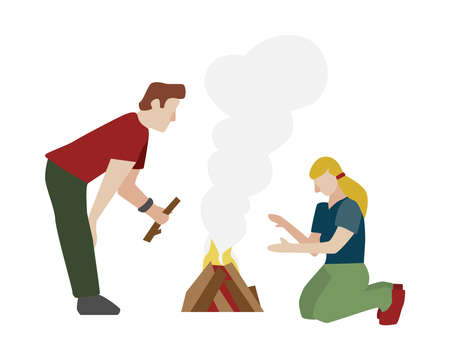Finding Your Footing: Recognising Signs of Distress
There is a quiet poetry to wandering the British countryside—mist clinging to rolling moors, ancient oaks whispering above winding woodland paths. Yet even amidst this beauty, the mind may become unsettled, leaving us vulnerable to stress, panic, and anxiety. It is vital to recognise the earliest signs of distress in ourselves and our companions before they take root. Pay close attention to subtle shifts: perhaps a friend who once delighted in birdsong now falls silent, their gaze fixed somewhere distant across the heather. Notice if your own steps falter or your breath grows shallow as you climb a bracken-lined hill. Are hands trembling when fastening a rucksack, or does someone seem restless, pausing often to scan the horizon? These gentle changes—withdrawal from conversation, agitation, or a sudden reluctance to continue—can be the first whispers of unease. The trail has its own rhythm; learning to notice when that rhythm stumbles allows us to offer help early, ensuring that the wild remains a place of solace rather than struggle.
2. Nature’s Embrace: Grounding Techniques from the British Countryside
When the mind grows unsettled on the trail, there is solace to be found in the gentle, grounding embrace of nature—especially here in the uniquely storied landscapes of Britain. Picture yourself on a footpath winding through ancient woodlands or across open moorland, where each element offers an invitation to return to the present moment. The crisp touch of a Cotswolds breeze, the distant song of skylarks over Yorkshire fields, or the earthy scent rising after a Welsh rain—these sensory gifts are more than just pleasantries; they are practical anchors for mindfulness when anxiety creeps in.
Utilising Local Senses for Mindfulness
Rather than battling your thoughts head-on, use what’s around you. Notice how the wind ruffles wild grasses at your feet or how sunlight flickers through oak leaves overhead. Let these sensations become points of focus, gently drawing your attention away from spiralling worries and back into your body and surroundings. Here’s a simple table to guide your practice using everyday features of the British countryside:
| Sense | Countryside Example | Mindful Practice |
|---|---|---|
| Touch | Mossy stone wall or cool stream water | Pause and press your palm against the stone or dip your fingers in the stream; note temperature and texture. |
| Sound | Lark’s call, rustle of hedgerows | Stand still and close your eyes; count and name each sound you hear until you feel settled. |
| Scent | Wet earth after rain, wild garlic in spring | Breathe deeply; identify scents and describe them silently to yourself. |
| Sight | Purple heather on moors, patchwork fields | Focus on colour variations or shifting light across the landscape. |
| Taste | Fresh air, bramble picked from a hedgerow (if safe) | Savour the freshness or flavour slowly, noticing every nuance. |
The Art of Slowing Down with Nature’s Rhythm
If panic or anxiety threatens to sweep you away, find a spot to pause—a mossy log beside an old beech tree, perhaps. Take three slow breaths, letting your lungs fill with air that smells of grass and earth. With each exhale, imagine releasing tension into the ground beneath you. Remember: these grounding practices are not about erasing discomfort but about holding it gently within the steadiness of nature’s presence. In this way, the British countryside becomes not just scenery but a quiet companion, helping you steady your mind as you walk onward.

3. Practical Tools for Calming the Waters
There’s a kind of quiet magic to the British countryside—rolling hills dusted with morning mist, the rhythmic crunch of boots on ancient paths, and the comforting presence of time-worn stone walls. Yet even here, far from the rumble of city life, anxious thoughts can sometimes slip in like brambles across a footpath. When stress or panic catches you off guard on the trail, simple, pocket-sized strategies rooted in nature and local tradition can help steady your mind.
Breathing in the Landscape
Start with your breath. Find a spot where you feel safe—a mossy verge beneath an old oak or beside a sun-dappled stile. Breathe deeply, following the pattern of four: inhale for four counts, hold for four, exhale for four, pause for four. Imagine drawing in the cool air from a Cornish sea breeze or the earthy scent after a Cotswold rain. Let your breath anchor you to this very moment, letting worries ebb away like tidewater at low moon.
Counting Landmarks: A Mindful March
If your thoughts are running wild, try gently reining them in by counting familiar features along your path. Tally five wooden fingerposts, three kissing gates, or every hedgerow sparrow that flits into view. This playful mindfulness invites your senses back into the present—turning each stile crossed or gate latched into a small victory over anxiety.
Drawing Strength from Traditions
The British trail is rich with heritage: waymarkers etched with acorns, cairns stacked by countless hands, and signposts that have seen centuries pass. Pause at these markers—trace their worn surfaces and reflect on all who have walked before you. Whisper an old walking rhyme or recall snippets of countryside lore passed down through generations. These rituals aren’t just charming—they remind you that you belong to something larger and enduring.
By weaving together breathwork, mindful counting, and cherished local customs, you create a toolkit as lightweight as it is powerful. Each method gently tethers wandering thoughts back to the solid ground beneath your boots—helping you find calm even when inner weather turns rough.
4. Leaning on Your Walking Circle: Reaching Out and Support
The gentle rhythm of boots on earth, the scent of wild thyme in the air, and the ever-changing British sky overhead — these moments are best shared with companions who truly look out for one another. When stress or anxiety creeps in along the trail, remember that you are never alone. Our walking circles, whether old friends or newfound mates, are woven together by a deep-rooted sense of camaraderie — a value cherished across Britain’s hills and valleys.
Encouraging Open Conversation
The first step towards real support is simple but powerful: starting an honest conversation. In your group, foster a space where feelings can be voiced without judgement. It’s not always easy to admit when we’re struggling, especially when spirits should be high and views so uplifting. Yet sharing even a small worry can lighten its load. Sometimes, just a word or two — “I’m feeling a bit off today” — is enough to open the door for kindness to step in.
Ways to Encourage Mutual Support
| Approach | How it Helps |
|---|---|
| Check-ins at rest stops | Allows everyone to express how they’re feeling physically and emotionally |
| Pair up with a buddy | Cultivates closer connections and makes it easier to speak up if something feels wrong |
| Share stories or past experiences | Normalises talking about mental health struggles; reduces stigma |
| Encourage humour and lightness | Laughter builds bonds and can diffuse tension during challenging moments |
The British Way: Looking Out for Your Mates
On UK trails, there’s an unspoken rule: no one gets left behind. This isn’t just practical — it’s emotional too. If someone lags or seems quiet, offer a gentle word or walk beside them for a while. Sometimes all it takes is a flask of tea shared under a drystone wall to remind each other that support is always close at hand. By leaning on your walking circle, you help ensure that every journey is not only about reaching the summit, but also about caring for those who walk beside you.
5. When the Clouds Don’t Lift: Knowing When to Seek Help
Sometimes, even as the wind changes and the sun peeks through, the clouds of anxiety and panic can linger overhead, stubbornly refusing to shift. It’s in these moments—when your mind feels heavier than your rucksack—that recognising the need for professional support becomes vital. Out on the trail or back in daily life, there’s no shame in admitting when self-care isn’t enough. The British landscape teaches us resilience, but also reminds us that not all storms are weathered alone.
Listening to Your Mind and Body
If feelings of stress, panic, or anxiety persist for days on end, affecting your sleep, appetite, or enjoyment of the outdoors, it’s a sign that you might need more than a cuppa and a deep breath. Notice if worries are spiralling out of control or if you’re avoiding walks you once loved. These are gentle nudges from within, asking for a little extra help.
Knowing Where to Turn in the UK
Fortunately, the UK has a network of services designed to support mental wellbeing. Your GP is often the first port of call—they’re well-versed in helping with emotional health as much as physical ailments. Many surgeries offer same-day appointments for urgent concerns or can point you towards talking therapies like CBT (Cognitive Behavioural Therapy).
Helplines and Local Services
If you find yourself struggling after hours or away from home, helplines like Samaritans (116 123) or Mind’s Infoline (0300 123 3393) offer confidential support at any time. For those who prefer not to talk on the phone, Shout provides text-based assistance (text ‘SHOUT’ to 85258). Exploring local community groups or charities can also provide connections and understanding among fellow walkers who’ve faced similar clouds.
Reaching Out is a Sign of Strength
Just as asking for directions is part of any good ramble, reaching out for mental health support is a practical step on the journey towards feeling better. The path may be muddy and unclear at times, but help is always closer than it seems—sometimes just over the next stile or at the end of a caring conversation.
6. The Journey Onward: Building Emotional Resilience Outdoors
As the woodland path unfurls before us, each step is more than just a movement forward—it’s a gentle act of self-care, woven into the ancient landscapes of Britain. While quick techniques can soothe panic or anxiety in the moment, true mental resilience is nurtured over time, in the company of green fields, coastal breezes, and rain-speckled moors. Here’s how you can cultivate long-term emotional well-being through your outdoor adventures.
Walking as a Ritual for Mind and Heart
Regular walks—be they along the winding lanes of the Cotswolds or beneath the towering pines of the New Forest—invite a rhythm that grounds our thoughts and soothes our nerves. Establishing walking as a personal ritual transforms it from mere exercise into a restorative practice. As you lace up your boots each week, let the anticipation of birdsong and shifting skies become a balm against life’s stresses.
Connecting with Local Walking Communities
Britain’s love affair with rambling is both historic and heartfelt. By joining local walking groups or ramblers’ associations, you not only discover hidden footpaths but also weave yourself into a supportive tapestry of fellow walkers. Shared stories by pub firesides or on windswept cliffs remind us we’re not alone—community is a powerful antidote to isolation and worry. These connections can lift spirits on even the gloomiest days.
Embracing Nature’s Changing Rhythms
The British countryside is never static; it shifts with every season, inviting us to find solace in its cycles. Notice how bluebells carpet ancient woods in spring, how heather paints hills in late summer, and how mist curls over autumn meadows. Observing these changes fosters mindfulness—a quiet attention to detail that gently anchors us in the present. Allow yourself moments of stillness: listen to wind through beech leaves or watch clouds drift across Dartmoor’s wide skies.
Sustaining Well-being Beyond the Trail
Ultimately, building emotional resilience outdoors isn’t about conquering mountains but learning to walk gently through all weathers, inside and out. Carry fragments of wild peace back into daily life—a memory of sunlight on water, the steady crunch of gravel underfoot. In doing so, every trail becomes part of an ongoing journey towards balance and well-being, wherever your boots may lead you next.


